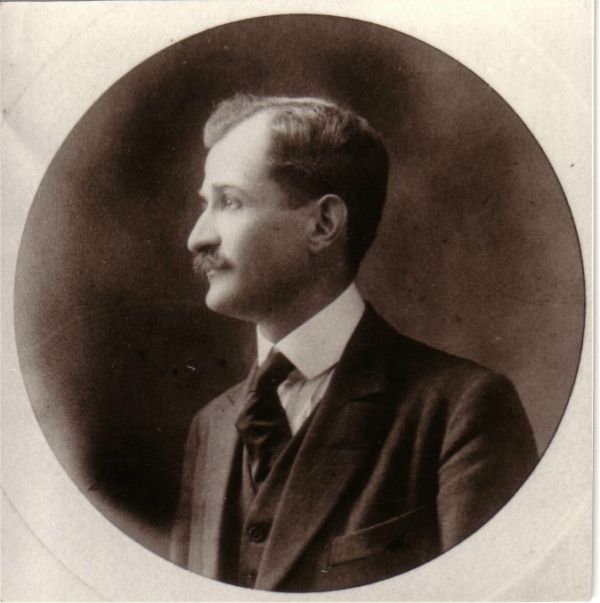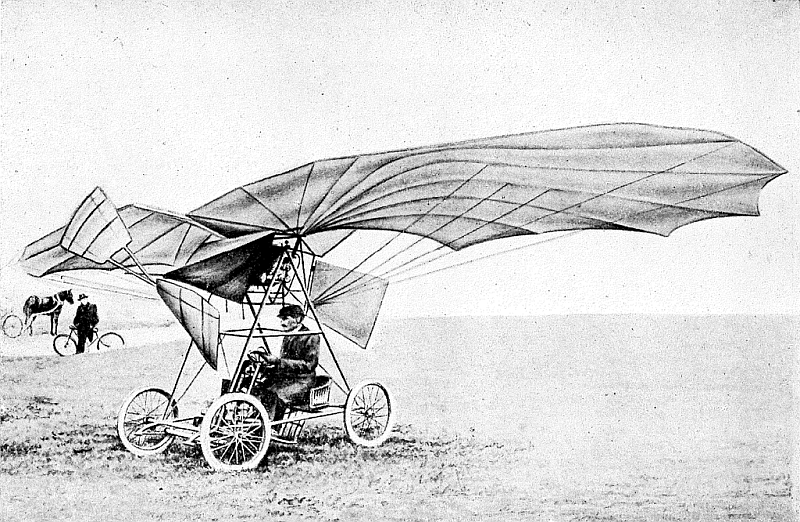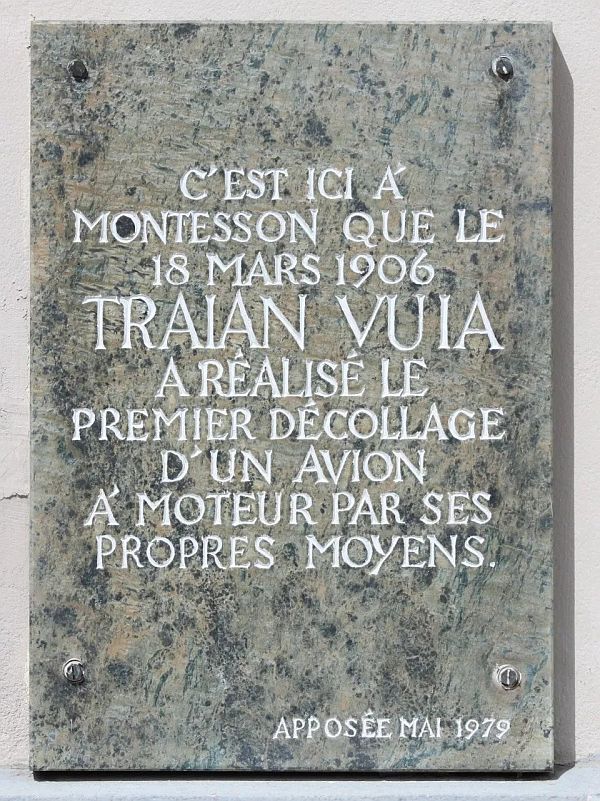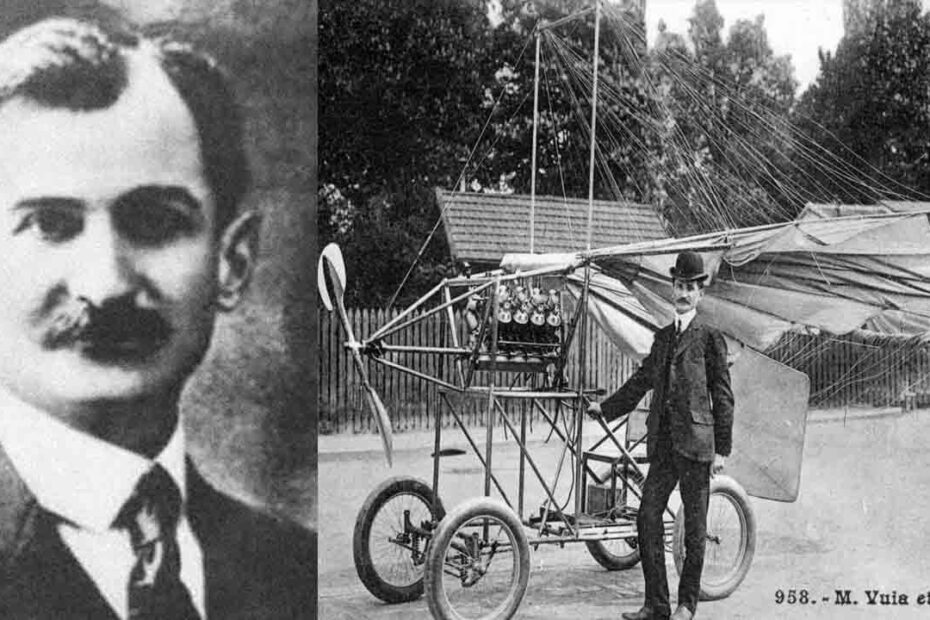Introduction
Who was Traian Vuia? Why are his life and legacy important?
Traian Vuia was a Romanian aviation pioneer and inventor.
His greatest achievement is that he proved for the first time in history that an object heavier than the air can take off and successfully fly, without any external help(catapult or launch pads)
Traian Vuia’s 1906 flight proved that his ideas were correct and this greatly influenced the scientific and technological progress in aviation.
By the standards of these days, Vuia’s achievement can be considered the first modern flight as we know it today.
Vuia’s road to this great achievement was not without challenges and obstacles, but the young Romanian inventor despite all the odds, didn’t give up on his dreams.
The Romanian inventor had to face strong opposition from many skeptics, while also fighting with his own financial problems.
This article is about the story of Traian Vuia and the achievement that helped him earn his well-deserved place in Aviation history.
I. Early life and career.

Born on November 1872, in the small village of Surducu Mic in Banat, then part of the Austro-Hungarian Empire.
Traian Vuia was the second child of a modest Romanian family.
His parents were Simion Popescu(local priest) and Ana Vuia, his second wife.
Simion and Ana raised 3 children: Elena, Traian and Ghizela.
Traian Vuia starts his primary education studies at the nearby schools in the towns of Faget and Bujor.
From a young age, many people remarked Traian Vuia’s passion for anything related to physics and mechanics.
Besides, mechanics and physics, his close friends and teachers from school noticed his interest in building kites and describing the forces behind flying these objects.
After graduating the primary education level, Traian Vuia continues his secondary-level education studies between the years 1882-1894 at the Roman Catholic High School in Lugoj.
After finishing his high school studies, Traian Vuia wanted to pursue an engineering career, so the obvious choice at the time was to apply to the Polytechnic University of Budapest.
Vuia joins the School of Mechanics section of this University, but because of his financial situation, he is unable to finish his studies and is forced to abandon the University after only 1 year.
Traian Vuia realizes that he needs to find a solution to overcome his financial problems so he applies to Law School.
The year of study at the Law School was a setback for Traian Vuia’s dreams.
Surprisingly Traian Vuia proved to be a good law student and even acquired a Ph.D. diploma in this field with the thesis” Military and Industry, State and Contract regime”.
Despite having a successful law career, Traian Vuia refused to abandon his ideal and dreams.
With new funds secured from his career law, Traian Vuia returns to Lugoj, where he resumes the work on his revolutionary project, called “the airplane-car”.
After several months of work in Lugoj on the revolutionary project, the number one enemy in the way of Traian Vuia’s projects makes its presence felt again, the lack of funds for the continuation of research.
Traian Vuia realizes that he could only hope to obtain the necessary funds if he called on the support of other great pioneers and aviation enthusiasts from that time.
Unfortunately, Romania had neither the financial resources nor the interest to support Vuia’s visionary project, so the natural option was to seek help in France, a country that at that time was recognized worldwide as a leader in the field of aviation research.
According to a historical source, before leaving for Paris, Traian Vuia told to his mother:
“I’m going, mother, to Paris. But don’t be sorry. I will come from there by flight or I will never come back.”
For Vuia, the path was clear, he was determined to transform his dreams into reality.
In July 1902, Traian Vuia arrives in Paris and starts looking for the necessary help for his innovative project.
II Arrival in France and the construction of his first airplane

Contrary to his expectations, the French specialists/scientists in Aviation were hesitant to support his visionary project.
Vuia initially hoped that he could count on financial help from balloon enthusiasts, unfortunately here, the Romanian inventor ran into many doubts and hesitations from enthusiasts who considered that his project was a utopia.
Far from being discouraged, Traian Vuia tries to get help from another recognized French pioneer and inventor, Victor Tatin.
Victor Tatin became famous after designing and building an experimental airplane in 1879 that flew successfully.
Vuia’s sketches arouse his curiosity, but he detects some flaws in the drawings and plans of the Romanian inventor. Those flaws would determine Tatin to advise against the continuation of the project.
Tatin presented 2 arguments against the project: the absence of a sufficiently powerful engine and the lack of maneuverability in handling the flying object.
Though Victor Tatin criticized Vuia’s ideas and drawings, he also provided some useful tips and advice to the young Romanian inventor that will later prove to be valuable(like a better engine and improved propellor)
It is also important to note that the propeller of the Vuia I airplane car was built with the help of Tatin.
After 2 failures in trying to get support for his project, Traian Vuia turns to experts from the Academie des Sciences(Academy of Sciences) in Paris.
On February 16, 1903, Traian Vuia presents his project in front of a special commission of French scientists.
The French academics, far from being impressed, rejected his project with the below remark:
“The problem of flying with an apparatus that weighs more than air cannot be solved and is only a dream.”
Despite overwhelming opposition to his ideas, Traian Vuia doesn’t give up. He was determined to show the world that his project was not “a dream”.
Showing extraordinary perseverance, he obtains a patent for his invention, called “airplane-car”(French: Aéroplane automobile) on August 17, 1903.(see Patent no 332106)
After obtaining the patent, Vuia begins the construction of his first aircraft, encouraged by the financial help obtained from his Romanian compatriots from Lugos(Gh.Dobrin, Coriolan Brediceanu were among the financial supporters).
Listening to the advice given by Tatin, Traian Vuia realizes that he must find a solution to the problem of the engine that will propel his plane.
Not finding an engine strong enough to propel his aircraft, Traian Vuia started to design and build one from scratch.
Towards the end of 1904, Vuia even manages to obtain a patent for his airplane engine in Great Britain.
In December 1905, with the installation of the engine, the assembly of the flying machine is completed.
The flying prototype would be called “Vuia I”, or “The Bat” due to the unusual appearance of the airplane.
See below the specifications of the “Vuia I” aircraft model
Span: 8.70 m (28.7 ft)
Length: 5.65 m (18.6 ft)
Height: 2.90 m (9.5 ft)
Lifting surface: 20 sq.m (217 sq.ft) Engine (using carbonic acid as fuel) : 20 HP at 450 rpm
Total Weight : 195kg (430 lb) + Vuia’s 56kg (124 lb) = 251kg (554 lb)
Traian Vuia’s “Airplane car”(French: Aéroplane automobile) brings several important innovations to aeronautical science and research of that time.
1. The airplane was a monoplane, at that time, the French and other aviation pioneers thought that the biplane was a superior design.
2. Vuia’s aircraft didn’t rely on catapults or any external means to take off. The flying prototype had the precursor of what we know today as flying gear.
3. His aircraft had only 1 propeller, while many experts of the time were in favor of using 2 propellers for most of the aircraft models.
III. Traian Vuia’s moment of glory

After finishing the construction of Vuia I, the Romanian inventor will first test it several times as a land vehicle without wings, so he can better learn how to maneuver it.
The testing phase took place in the field of Montesson in the early part of the year 1906.
On March 18, 1906, Traian Vuia finally decides to take off with his airplane.
After accelerating for 50 meters, the plane successfully takes off, reaches an altitude of 1 meter, and maintains height for a distance of 12 meters.
During this short flight, the engine and propeller suddenly stop.
The aircraft was then briefly carried by the wind and crashed into a tree, suffering minor damage.
Vuia’s great achievement was published in many major newspapers and publications of the time from France, the United States, and the United Kingdom.
Traian Vuia’s exceptional flight was mentioned on the same day, by a Parisian magazine: “At Montesson, an airplane built by Traian Vuia rose from the ground with its own means and flew 12 meters“
Another French famous aeronautical magazine L’Aerophile in an article from September 1906 mentions in an article about Vuia’s success: “Mr. Vuia is the first person in our country (France) to have really attempted, with a machine able to carry a man, the direct take-off of an airplane”.
- Controversy.
During Vuia’s first flight at Montesson, on March 18, 1906, only a few people witnessed the important event.
The flight didn’t take place in the presence of French officials or aviation specialists.
This could be also the main reason why the French choose instead to officialize the flight of Santos-Dumont as the first flight without any external help.
Santos-Dumont’s flight took place in October 1906, a few months later that all of Vuia’s flights with his models, Vuia I and Vuia I bis.
The Romanian inventor also has his share of the blame, for letting the French officials certify Dumont’s flight.
Maybe modesty or maybe another unknown reason, but Vuia didn’t ever attempt to contest the decision of the French aviation specialists and claim his rights.
During a conversation with a friend, Vuia was asked why he never claimed his rightful place. The Romanian inventor simply answered:
“What does it matter who did it one thing: the important thing is that it exists. I never sought glory, because
I know that glory often loses a man… I do not work for my personal glory, but I work for the glory of human genius“.
IV. Other airplane models and flights

After some time, Vuia improved his initial “airplane car”, and in August 1906 presented an improved version of it, called “Vuia I bis”.
With this model, until March 1907, he performed several experiments and made several flights at different heights.
Unlike the first model, the airplane had a smaller wing sweep, an adjustable stabilizer, and improved engine efficiency.
Encouraged by the results of “Vuia I” and “Vuia 1 Bis”, the Romanian inventor built a second and improved Airplane model and baptized Vuia II.
Unlike the previous flying prototypes, Vuia II was powered by a new engine, an Antoinette of 25 HP.
The weight of this new aircraft was lowered to 215 kg(initial versions weighted around 240-275 kg).
The new airplane was successfully tested at Bagatelle Gamefield, on July 1907.
Traian Vuia achieves a flying distance of 70 meters with his new airplane.

Vuia II was so effective that it was even exhibited at the Aeronautical Salon in Paris.
V. Other achievements and inventions
During WWI, the great Romanian inventor worked in the Bureau of Inventions within the French Ministry of War.
During this time, with his old friend, Victor Tatin, they created a torpedo that entered the service of the French Navy.
After the end of the First World War, Traian Vuia collaborated with French inventors/pioneers on different models of helicopters, showing a real interest in perfecting vertical take-off.
In 1918, together with the French inventor Emmanuel Yvonneau, Vuia designed and built his first helicopter prototype. The helicopter model was to be tested at the Juvisy airport in 1920.
The prototype, called Vuia no. 1, was simplistic, being operated by the pilot’s muscular strength.
Vuia’s attempts to perfect vertical flight didn’t stop there.
In 1922, Vuia successfully tested a second model of helicopter, Vuia no. 2, this time equipped with an 8 HP Anzani engine.
The helicopter was tested by the French pilot Laurent in the same year, also at the Juvisy airfield.
The device responded well to commands and even rose several meters in the air.
And this time, the lack of financial resources prevented Traian Vuia from perfecting his inventions.
After these achievements, Traian Vuia was also concerned with the creation of powerful engines capable of helping to achieve long-duration flights.
Together with Emmanuel Yvonneau, Traian Vuia designed, built, and patented 3 models of steam generators between 1928 and 1932.
V. Political and social activities
On the initiative of Traian Vuia, on April 30, 1918, the “National Committee of Romanians from Transylvania” was established in Paris, an organization that campaigned for the union of Transylvania with Romania. The committee also edited a magazine, “La Transylvania”, in which Traian Vuia also collaborated with several articles.
Vuia published articles on the same topic in the magazine “La nation tchèque”. However, he was very critical of how the Union of Transylvania with the Romanian Kingdom was carried out, considering it a big mistake not to negotiate the Union of the province with the Romanian Kingdom, which would have defended the interests of the Transylvanians and allowed over time a “westernization” of Romania and not vice- vice versa, a “balkanization” of Transylvania.
During the Second World War, Vuia was part of the resistance movement in France and was elected president of the first legal committee of the “Romanian National Front”, where he worked hard and published a series of articles in ” La Roumanie Libre”.
Traian Vuia was elected an honorary member of the Romanian Academy on May 27, 1946.
After WWII, he will return in Romania, and on September 03, 1950, he passes away.
Shortly afterward, Traian Vuia is buried at Bellu Cemetery in Bucharest.
VI. In his honor…
Vuia’s career represents is the living proof that with perseverance and ingeniosity nothing is impossible, and that dreams can be transformed into reality.
Vuia’s successful flight at Montesson, in 1906 marks the beginning of a new era in aviation and not only.
Later, in 1923, the Romanian inventor told to a close friend:
“Tell your friends at home everything you saw here. We proved that a heavier-than-air device can fly. Now, the number of experiments will increase rapidly, and specialists will make special engines. Aviation will have a thriving industry. You could see, I didn’t hide, I experimented in plain sight. More and more will continue. This is how progress is made.”
For his great achievements, Vuia’s memory is honored in several ways in modern-day Romania.
-his hometowns were renamed after him
-many Romanian high schools from the cities of Bucharest, Craiova, Faget, Focsani, Satu Mare, Targu Jiu, Galati, and Oradea were named after him.
– the International Airport of Timisoara, the third largest airport in Romania, has been named after him. Also, a 1:1 replica of Vuia I, the first plane of the Romanian inventor was placed near it to commemorate its achievement.
-in 2022, a replica of Vuia’s first plane was built by Romanian students from Resita and placed in the courtyard of the High School with the same name.
– the French local authorities from Montesson decided to commemorate Vuia’s memory by unveiling a memorial plaque, naming a local street after him, and installing a statue of the Romanian inventor in the local Town Hall.

The memorial plaque installed by the French local authorities from Montesson clearly specify Traian Vuia’s great achievement, that his plane took off without any external help.
VII. Sources:
Romanian books and websites:
Istoria Aviatiei Romane, Editura Stiintifica si Enciclopedica Bucuresti, 1984
Gh, Lipovan, Traian Vuia realizatorul zborului mechanic, Bucuresti, Editura tehnica,1956
Elena Boruga, Traian Vuia 1872-1950 Studiu Monografic si Catalog, Editura Timisoara, 1999
Other sources:
